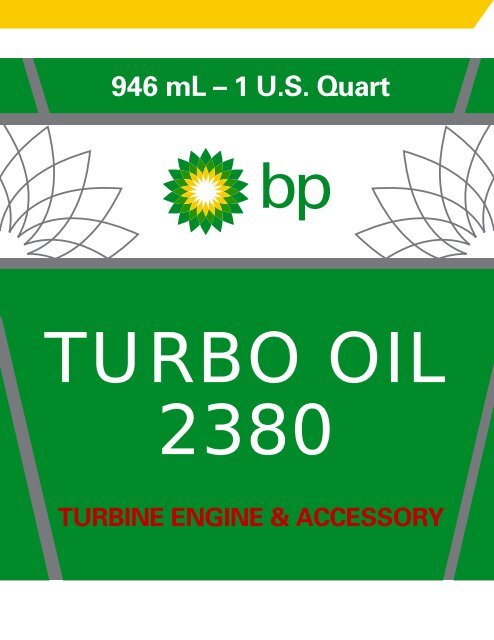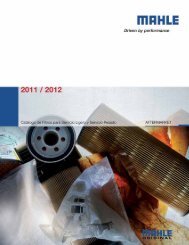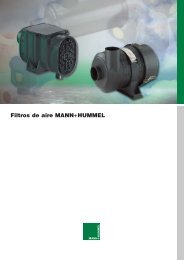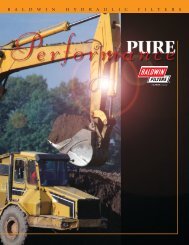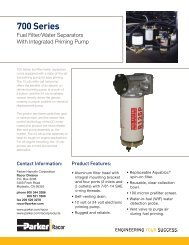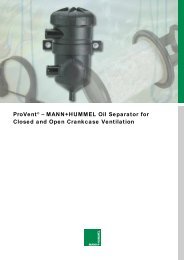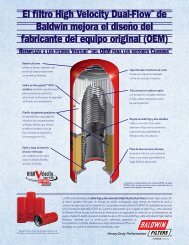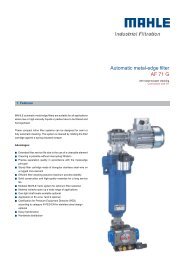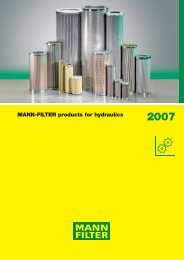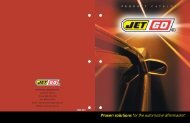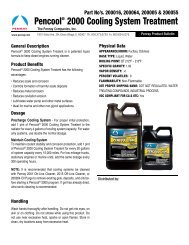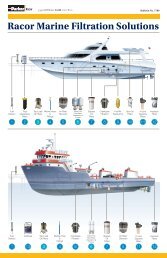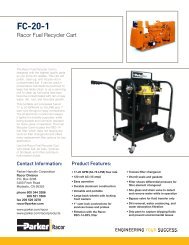946 mL – 1 U.S. Quart - BP
946 mL – 1 U.S. Quart - BP
946 mL – 1 U.S. Quart - BP
Create successful ePaper yourself
Turn your PDF publications into a flip-book with our unique Google optimized e-Paper software.
<strong>946</strong> <strong>mL</strong> <strong>–</strong> 1 U.S. <strong>Quart</strong><br />
TURBO OIL<br />
2380<br />
TURBINE ENGINE & ACCESSORY
I n t ro d u c t i o n<br />
While the changing of our label for turbo oil is relatively<br />
new, our experience in lubricating turbine engines is<br />
not. In 1949 the Research Division, which was initially<br />
responsible for the development of our turbo oils,<br />
helped turn the vision of gas turbine powered flight into<br />
the reality we accept for granted today. By developing<br />
the first synthetic oil that could be used successfully in<br />
gas turbine engines, much wider fields to the aircraft<br />
designer were opened. This position of leadership has<br />
never been relinquished and you can depend on us just<br />
as you did in 1949.<br />
<strong>BP</strong>TO 2380<br />
<strong>BP</strong> Turbo Oil (<strong>BP</strong>TO) 2380, available throughout the<br />
world, is now being used by over 350 airlines<br />
representing a majority of the free world’s commercial<br />
airline requirement for 5 cSt turbo oils. This fact attests<br />
to the outstanding performance of this product in the<br />
wide variety of engines and accessories now in service.<br />
Table of Contents<br />
Page<br />
Product Description . . . . . . . . . . . . . . . . . . . . . . . . . . . . . . 2<br />
Product Performance. . . . . . . . . . . . . . . . . . . . . . . . . . . . . 3<br />
A p p r o v a l s. . . . . . . . . . . . . . . . . . . . . . . . . . . . . . . . . . . . . . . 4<br />
Technical Service . . . . . . . . . . . . . . . . . . . . . . . . . . . . . . . . 6<br />
Quality Control . . . . . . . . . . . . . . . . . . . . . . . . . . . . . . . . . . 6<br />
Future Outlook . . . . . . . . . . . . . . . . . . . . . . . . . . . . . . . . . . 6<br />
Health and Safety Precautions . . . . . . . . . . . . . . . . . . . . 7<br />
A p p e n d i x . . . . . . . . . . . . . . . . . . . . . . . . . . . . . . . . . . . . . . . 8<br />
Typical Inspections<br />
Printed in U.S.A., 04/02<br />
1
P roduct Description<br />
<strong>BP</strong>TO 2380 is a synthetic oil having a viscosity of 5<br />
centistokes at 210°F that is approved against US<br />
military specification MIL-PRF-23699F-STD, DEF STAN<br />
91-101/2* (DERD 2499), and meets the requirements of<br />
most jet engines and associated accessories. It is a<br />
Type II oil which provides a more balanced combination<br />
of thermal and oxidation stability, load-carrying capacity,<br />
lower volatility and low temperature flow characteristics<br />
than other 5 cSt jet engine oils. These features provide<br />
long trouble-free performance under most conditions.<br />
Synthetic oils of this type are not all identical. The<br />
performance advantages of <strong>BP</strong>TO 2380 are achieved by<br />
careful selection and balance of basestocks and<br />
additives to provide the desired performance.<br />
Details of laboratory analyses of physical, chemical,<br />
and performance properties are provided in the<br />
Appendix. Significant performance properties are<br />
discussed below. Where detailed information on the<br />
laboratory test methods and the significance of results<br />
is desired, a member of our <strong>BP</strong> technical staff will be<br />
happy to provide them.<br />
V I S C O S I T Y : While most Type II synthetic turbo oils<br />
have essentially the same viscosity at 99°C (between 5<br />
and 5.5 centistokes), <strong>BP</strong>TO 2380 is less viscous at very<br />
cold temperatures than other Type II oils. This offers a<br />
distinct advantage, which permits <strong>BP</strong>TO 2380 to be<br />
used in some critical applications where other Type II<br />
oils are excessively viscous. For example, at -40°C the<br />
viscosity of <strong>BP</strong>TO 2380 is well below that of<br />
competitive products.<br />
Competitive Products<br />
<strong>BP</strong>TO 2380 A B<br />
Viscosity, cSt<br />
at -40°C 7950 12 , 390 10 , 640<br />
VAPOR PHASE DEPOSITS: A major advantage of<br />
<strong>BP</strong>TO 2380 is its ability to limit vapor-phase deposits.<br />
With some competitive oils, heavy deposits have<br />
formed where the oil mist and vapors come in contact<br />
with hot engine surfaces resulting in migrating deposits.<br />
LOAD CARRYING: <strong>BP</strong>TO 2380 provides load carrying<br />
ability, as measured in the Ryder Gear Test well in<br />
excess of requirements established by the engine and<br />
equipment manufacturers. Long life of bearings, gears,<br />
and other highly loaded lubricated surfaces is thus<br />
assured under normal operating conditions.<br />
C L E A N L I N E S S : Minimum formation of varnish or<br />
sludge deposits is one of the characteristic advantages<br />
of <strong>BP</strong>TO 2380. Long periods of operation are possible<br />
without the danger of scavenge pump screen plugging<br />
or the corrosion that often accompanies excessive<br />
d e p o s i t s .<br />
BULK STABILITY (resistance to physical or chemical<br />
change resulting from oxidation): The high<br />
degree of oxidation resistance of <strong>BP</strong>TO 2380 permits<br />
long periods of operation without significant increase in<br />
viscosity or total acidity, the two principal indicators of<br />
product oxidation. The need to change oil because of<br />
oxidation effects is rare when using <strong>BP</strong>TO 2380. Most<br />
users find it unnecessary to make oil changes in spite of<br />
occasional mechanical abnormalities that create<br />
unusually severe oxidizing conditions.<br />
C O M P A T I B I L I T Y :While considerable laboratory data is<br />
available to demonstrate the compatability of <strong>BP</strong>TO<br />
2380 with metals, elastomers and other lubricants, the<br />
extensive airline experience most adequately demonstrates<br />
this property. Details are given in the section on<br />
“Product Performance.”<br />
SEAL WEAR: Proper functioning of carbon seals is<br />
essential for the life of the engines that use this type of<br />
bearing compartment sealing arrangement. Poor seal<br />
performance may be caused by lubricant properties that<br />
promote (or fail to prevent) wear of the carbon at the<br />
carbon-to-steel face. <strong>BP</strong>TO 2380 has provided the<br />
dependable performance in numerous airlines that was<br />
predicted by extensive laboratory tests.<br />
* <strong>BP</strong>TO 2380 is approved against DEF STAN 91-101/2 (DERD 2499)<br />
for both OX-27 and OX-28 requirements. OX-27 is for use in military<br />
gas turbines and accessories. OX-28 is for use in marine gas<br />
t u r b i n e s .<br />
2
P roduct Perf o rm a n c e<br />
AIRLINE SERVICE: The fact that <strong>BP</strong>TO 2380<br />
represents the majority of the free world requirement<br />
for 5 cSt turbo oils speaks highly of its performance.<br />
Over 350 airlines are now accumulating approximately<br />
50 million engine hours a year on this lubricant.<br />
Outstanding bulk stability, excellent cleanliness, as<br />
evidenced by low deposit levels in vapor phase areas,<br />
and very good anti-corrosion qualities have made <strong>BP</strong>TO<br />
2380 the leader in gas turbine lubrication.<br />
OIL CONSUMPTION: Typical consumption with <strong>BP</strong>TO<br />
2380 ranges from a low of 0.07 litres (0.06 quarts) per<br />
engine hour to a high of 0.59 (0.62).<br />
Evaporation loss—though a factor—is a minor one.<br />
Based upon laboratory tests, <strong>BP</strong>TO 2380 has a<br />
directional advantage in this respect.<br />
Evaporation Loss,<br />
% at 6 1 ⁄2 hours <strong>BP</strong>TO 2380 Oil A<br />
at 400°F, Sea Level 3 . 85 4.58<br />
at 400°F, 40,000 ft. 8 . 80 10.09<br />
at 450°F, Sea Level 11 . 81 15.62<br />
at 450°F, 40,000 ft. 21 . 50 27 . 82<br />
In actual practice, the data suggest that engines cannot<br />
distinguish differences in consumption among various<br />
Type II oils. Experience in monitoring oil consumption<br />
over long periods indicates that:<br />
a. Oil consumption is governed more by mechanical<br />
factors than by differences between oils of similar<br />
type.<br />
b. The principal factor related to lubricant chemistry that<br />
affects oil consumption is volatility or loss by<br />
evaporation and this effect is minor.<br />
c. Large differences in consumption among airlines<br />
operating identical equipment in similar route structures<br />
with the same oil are generally attributed to<br />
differences in methods of data collection and record<br />
k e e p i n g .<br />
C O M P A T I B I L I T Y<br />
<strong>BP</strong>TO 2380 is compatible with other turbo oils meeting<br />
the same specifications to the extent that an<br />
inadvertent mixing or emergency top-off with another<br />
approved brand will not cause additive separation to<br />
occur. However, most engine builders do not<br />
recommend indiscriminate mixing of approved oils<br />
and we agree with this principle.<br />
<strong>BP</strong>TO 2380 performance is outstanding in the critical<br />
area of compatibility with elastomers such as those<br />
used in O-ring seals. Excessive swelling or shrinking of<br />
seals can cause severe oil leakage. In new engines or in<br />
high-time engines where <strong>BP</strong>TO 2380 has replaced<br />
another lubricant, there has been no known incident of<br />
oil leakage due to oil-elastomer incompatibility.<br />
Deposit washing is a problem with some turbo oils. This<br />
is the situation where engine deposits, laid down by a<br />
previous oil, can sometimes be loosened or washed off<br />
by changing to a different oil. The loosened deposits<br />
can plug filter screens, which seriously reduces oil flow.<br />
This is more apt to occur when changing over high-time<br />
engines where deposits have had a chance to dry out<br />
during short-term storage or deactivation for service or<br />
repair. Laboratory tests and many years of service have<br />
shown that changing engines to <strong>BP</strong>TO 2380 should<br />
cause no concern about deposit loosening and<br />
migration, under normal circumstances.<br />
SHELF LIFE<br />
The shelf life of <strong>BP</strong>TO 2380 can extend beyond four<br />
years when stored in original, unopened quart cans<br />
under acceptable conditions, such as away from<br />
extreme heat and moisture. Likewise, drummed<br />
product (includes 55 gallon drum and 5 gallon pails) has<br />
an expected shelf life of three years minimum. For all<br />
package styles, shelf life can be increased significantly<br />
beyond those stated above, depending upon storage<br />
conditions. Please contact your bp representative if you<br />
have any questions about product usability.<br />
3
A p p ro v a l s<br />
<strong>BP</strong>TO 2380 is approved for use in most engines and<br />
accessories in airline service today. The approvals listed<br />
below are current as of the time of printing; however,<br />
the respective manufacturer’s manuals and service<br />
bulletins should be consulted.<br />
E N G I N E S<br />
CFM International: <strong>BP</strong>TO 2380 is approved for use in<br />
CFM 56 engines (CFM 56 Service Bulletin 79-001).<br />
F l y g m o t o r : <strong>BP</strong>TO 2380 is approved for RM8A, B<br />
engines (approved on a proprietary basis by Volvo<br />
F l y g m o t o r ) .<br />
General Electric Company: <strong>BP</strong>TO 2380 conforms to<br />
GE Spec. D50TF1-S4 Class B and is fully qualified for<br />
use in most GE models according to:<br />
CJ610 Maintenance Manual Page 202A/202B<br />
CF700 Maintenance Manual Page 202<br />
CF6 Service Bulletin 79-1<br />
CF34 Maintenance Manual Section 72-00-00<br />
CT7 Maintenance Manual Section 72-00-00<br />
H o n e y w e l l / A l l i e d S i g n a l : <strong>BP</strong>TO 2380 is approved for<br />
use in TPE-331, TSE 331 (Service Information Letter<br />
P331-2) and TFE-731 engines (Service Information<br />
Letter F731-11).<br />
<strong>BP</strong>TO 2380 is approved for use in T-53 engines (Service<br />
Bulletin No. 36) and T-55 engines (Lycoming letter of<br />
Sept. 5, 1975). <strong>BP</strong>TO 2380 is also approved for ALF 502<br />
engines (ALF 502 Maintenance Manual—Section 72-00-<br />
00 page 12) and LF 507 engines (LF 507-1H<br />
Maintenance Manual—Section 72-00-00 page 23).<br />
IAE International: <strong>BP</strong>TO 2380 is approved for the<br />
V2500 engine (IAE V2500 series documents IAE-0043<br />
and IAE-0174).<br />
M o t o r l e t : <strong>BP</strong>TO 2380 is approved for the M601 engine<br />
(Motorlet letter dated Aug. 9, 1994).<br />
Pratt & Whitney: <strong>BP</strong>TO 2380 is approved under<br />
specifica-tion PWA 521 (Service Bulletin No. 238) for<br />
use in all models of engines.<br />
Pratt & Whitney Canada: <strong>BP</strong>TO 2380 is approved for<br />
use in all PT6, ST6, (Service Bulletin Nos. 1001, 3001,<br />
4001, 5001, 9001, 10001, 11001, 12001 and 13001),<br />
JT15D (Service Bulletin No. 7001), PW100 series<br />
engines (S/B 20001), and PW300 series engines (S/B<br />
2 4 0 0 1 ) .<br />
Rolls-Royce Ltd.: <strong>BP</strong>TO 2380 is fully approved for Spey<br />
models (Service Bulletin SP 12-8), for use in Avon<br />
4<br />
models (Service Bulletin, AV 89-22), and for use in<br />
Gnome models H1400 and H1400-1 (Type Approval<br />
Certificate No. Gnome 4&5, respectively). <strong>BP</strong>TO 2380 is<br />
fully approved for the RB 211-524 models (Service<br />
Bulletin RB 211-12-5019) and RB 211-535C<br />
(Maintenance Manual M-211 (535)-B Section 12-13-01).<br />
<strong>BP</strong>TO 2380 is also approved for the RB 211-22B models<br />
(Service Bulletin RB 211-12-5019) and for Tay models<br />
(all Marks) (R-R letter dated 17 July 1986 and 24 May<br />
1990). <strong>BP</strong>TO 2380 is approved for all GEM marks (R-R<br />
approval letter issue 3.1 March 1988).<br />
Rolls-Royce/Allison Engine Company: <strong>BP</strong>TO 2380 is<br />
approved against EMS 53 and for use in 250, 501 and<br />
T56 series engines according to customer service<br />
letters:<br />
250-C18 CSL-2<br />
250-B15G TP CSL-2<br />
250-C20/C20B CSL-1002<br />
250-B17/B17B TP CSL-1002<br />
250-C28 CSL-2002<br />
250-C30 CSL-3002<br />
501-D13 CSL 161<br />
501-D22 CSL 1002<br />
501-D36 CSL 2002<br />
T56-A-14 CSL 4002<br />
T56-A-15 CSL 1502<br />
N O T E : Future 250 oil approvals will be listed in<br />
Section 72-00-00 of the respective operation and<br />
maintenance manual for each engine model.<br />
<strong>BP</strong>TO 2380 is also approved for the AE 2100 and AE<br />
3007 engine models.<br />
R o l l s - R o y c e / S N E C M A :<strong>BP</strong>TO 2380 is approved for use<br />
in M.45H (Rolls-Royce letter of Dec. 4, 1975).<br />
Rolls-Royce Turbomeca: <strong>BP</strong>TO 2380 is approved for<br />
Adour engines (Rolls-Royce Technical Instruction 28).<br />
S N E C M A : <strong>BP</strong>TO 2380 is fully approved for use in all<br />
Atar series engines (Technical document MTC No.<br />
6015, latest edition), for the M53 engine (SNECMA<br />
letter dated 10/1/87), and for the M88-2 engine<br />
(SNECMA letter dated Nov. 21, 1995).<br />
T u r b o m e c a :<strong>BP</strong>TO 2380 is approved (Turbomeca letter<br />
to ESAF in 1994) for following engines:<br />
Arriel<br />
Makila<br />
Astazou XVI A r r i u s<br />
TM 333<br />
<strong>BP</strong>TO 2380 is approved as alternate (with restrictions)<br />
for the Astazou (except XVI), the Artouste and the<br />
Bastan engines. See applicable maintenance manual for<br />
s p e c i f i c s .<br />
T u r b o m e c a — S N E C M A : <strong>BP</strong>TO 2380 is approved for<br />
the Lazarc engines (SNECMA letter Nov. 18, 1975).
A p p rovals (Cont’d)<br />
A C C E S S O R I E S<br />
Carrier Corporation: <strong>BP</strong>TO 2380 is approved for use in<br />
Carrier Freon compressors (Carrier letter dated April 25,<br />
1969 to Seaboard World Airlines).<br />
Foote Brothers Company: <strong>BP</strong>TO 2380 is approved for<br />
gear box for JT3C-6 engines and for two-speed gear<br />
box on Electra aircraft.<br />
General Electric Company: <strong>BP</strong>TO 2380 conforms to<br />
GE specification D50TF1-S4 class B and is approved for<br />
use in CSD Model 2CLKH40B9.<br />
Hamilton Sundstrand<br />
S t a r t e r :<strong>BP</strong>TO 2380, via its MIL-PRF-23699 approval,<br />
is approved for the following starter units: PS200,<br />
PS600, PS700.<br />
APU: <strong>BP</strong>TO 2380 is approved for Model P&WC ST6L<br />
(Pratt & Whitney Canada, SB No. 9001). <strong>BP</strong>TO 2380<br />
is approved for APU models APS500, APS1000,<br />
APS2000, APS3200 via its MIL-PRF-23699 approval.<br />
Air Cycle Machines: <strong>BP</strong>TO 2380 is approved for<br />
R70-3W air cycle machine. (Service Bulletin HS Code<br />
R70-3W No. 8). It is also approved for R72-3W,<br />
R76-3WR as well as ACM’s in 747 and L-1011<br />
(Appropriate service manuals and Hamilton Standard<br />
letter 9/1/83).<br />
C S D / I D G : <strong>BP</strong>TO 2380 is approved for all constant<br />
speed drive and integrated drive generator models<br />
(Sundstrand Component Maintenance Manual part<br />
no. 729184 section 24-11-66).<br />
Honeywell/AlliedSignal<br />
S t a r t e r s : <strong>BP</strong>TO 2380 is approved for all starters<br />
(AiResearch Engineering Report GT-7800J).<br />
Lucas Aerospace Ltd.: <strong>BP</strong>TO 2380 is approved for the<br />
AE 8909 integrated drive generator in Concorde (Lucas<br />
Engineering Report CS 0284).<br />
M i c r o t u r b o :<strong>BP</strong>TO 2380 is approved for use in Saphir I,<br />
II, and III, and IV APU (Service Bulletin 49-10-07).<br />
Normalair Ltd.: <strong>BP</strong>TO 2380 is approved and<br />
recommended for cold air unit (ref. Operator’s Manual).<br />
Plessey Company Ltd.: <strong>BP</strong>TO 2380 is fully approved<br />
for use in CSDS units manufactured by the Plessey<br />
Company Ltd. (letter dated Sept. 18, 1970).<br />
Pratt & Whitney Canada: <strong>BP</strong>TO 2380 is approved for<br />
use in the PW901A APU (Ref. Component Maintenance<br />
Manual APU part no. 3910001).<br />
Rotax Ltd.: Approvals and approval procedures for<br />
Rotax Ltd. CSD units require discussion with<br />
m a n u f a c t u r e r .<br />
S o l a r : <strong>BP</strong>TO 2380 is approved for APU models T-62T-<br />
25,-29,-39,-40 via its MIL-PRF-23699 approval.<br />
T u r b o m e c a :<strong>BP</strong>TO 2380 is approved for use in the AST<br />
600 auzillary power unit (APU). It is approved as<br />
alternate (with restrictions) on the AST 950 APU. See<br />
applicable maintenance manuals.<br />
O T H E R<br />
Bell Helicopter Co.: <strong>BP</strong>TO 2380 is approved for use in<br />
engine, transmission, and tail rotor gear box of Models<br />
206, 212, 214 and in engine and transmission of model<br />
222 helicopter (Bell Materials Bulletin FW 1440C).<br />
Sikorsky Aircraft Division: <strong>BP</strong>TO 2380 is approved for<br />
use in engine, intermediate gear box, and tail gear box<br />
of models S61L and S51N. (Sikorsky Notice To<br />
Commercial Operators 61-94).<br />
Auxiliary Power Units and Ground Power Units:<br />
<strong>BP</strong>TO 2380 is approved for all models (AiResearch<br />
Engineering Report GT-7800J).<br />
Turbo Machinery: Cooling turbines, engine-driven<br />
compressors, turbine-driven compressors, and<br />
turbine-driven fans. <strong>BP</strong>TO 2380 is approved for most<br />
models in this group (S.I.L. 100-300).<br />
Turbine Reversing Actuator: Part No. 127038-1-3<br />
uses engine oil and <strong>BP</strong>TO 2380 is approved (P&W<br />
SB No. 238).<br />
5
Technical Serv i c e<br />
<strong>BP</strong> provides technical service in support of our products<br />
and their performance. The two vital elements of this<br />
service consist of a highly qualified Technical Staff and a<br />
complex of Sales Service Laboratories. As the name<br />
implies, the Technical Staff maintains contact with<br />
customers, engine and airframe manufacturers, and<br />
accessory equipment manufacturers. The Sales Service<br />
Laboratories provide laboratory services to assist in<br />
used oil analyses.<br />
TECHNICAL STAFF<br />
The Technical Staff consists of aviation career<br />
specialists to provide service to customers and to work<br />
with major airframe and engine builders. These<br />
specialists have at their disposal the full facilities of<br />
Sales Service Laboratories and <strong>BP</strong> product research<br />
facilities. This system ensures that each individual is<br />
well informed on equipment developments, industry<br />
problems and product performance. Thus, while only<br />
one member of the Technical Staff will be the principal<br />
contact with a customer, that member will reflect the<br />
experience and knowledge of the entire organization<br />
and will have ready access to all facilities of the<br />
corporation for assistance as required on behalf of his<br />
assigned accounts. The fact that the Technical Staff is<br />
part of the headquarters of their respective<br />
organizations assures that the staff members have<br />
headquarters’ authority to assist in effective handling of<br />
their assignments .<br />
<strong>BP</strong> provides worldwide technical service in support of<br />
turbo oil customers. Service is coordinated by Air <strong>BP</strong><br />
Lubricants from its office in Parsippany, New Jersey.<br />
SALES SERVICE LABORATORIES<br />
The Sales Service Laboratories are located throughout<br />
the world at <strong>BP</strong>’s major refineries and blending plants.<br />
These laboratories in turn are backed up by the full<br />
facilities of <strong>BP</strong> research facilities in Naperville, Illinois.<br />
PRODUCT SAMPLE PROCEDURES<br />
AND HANDLING<br />
The base purpose of analyzing product samples is to<br />
assist in solving or defining a problem that may be<br />
related to the performance of the lubricant. Thus, the<br />
sample size and handling procedures may vary with the<br />
nature of the suspected problem and with the analytical<br />
techniques required for definition and solution.<br />
Experience has provided standardized procedures<br />
applicable in many instances. Details are available from<br />
a member of the Technical Staff.<br />
Quality Contro l<br />
<strong>BP</strong>TO 2380 is blended in batches with each batch composed<br />
of the identical chemicals, in the same<br />
proportions, used in all previous batches. Approximately<br />
25 tests are performed on each batch to evaluate the<br />
physical, chemical and performance characteristics of<br />
the product. Historically, the batch-to-batch variations<br />
are within the limits of test repeatability.<br />
As each batch is prepared, a quantity of product is set<br />
aside in sealed containers. Periodically, a container is<br />
opened and tested to ensure that no change has<br />
occurred in the physical or chemical properties as a<br />
result of time. Customers can enhance the product<br />
storage stability life by using first-in, first-out inventory<br />
procedures and maintaining the oil under normal<br />
storage conditions (indoors protected from excessive<br />
heat). Within these parameters, experience has shown<br />
<strong>BP</strong>TO 2380 shelf life has no effect on its performance.<br />
It is suggested that oil that has been exposed to<br />
extremes of high temperature and humidity in storage<br />
be retested.<br />
Most important in monitoring product quality is the<br />
frequent observation of airline engines and accessories.<br />
A specialized rating system has been developed by the<br />
Technical Staff in cooperation with the product research<br />
facilities. This system provides for numerical<br />
descriptions of engine mechanical condition and<br />
lubricant performance for all critical lubricated<br />
components. By this means, the conditions of two or<br />
more engines can be compared even though they may<br />
be inspected at different times. The system thus<br />
provides a yardstick for measuring the uniformity of<br />
performance in operating engines. This method of<br />
documentation also permits an appraisal of engine<br />
mechanical condition, an evaluation of the effectiveness<br />
of mechanical modifications and a comparison of the<br />
performance of different lubricants.<br />
F u t u re Outlook<br />
As documented in previous sections, <strong>BP</strong>TO 2380 is providing<br />
outstanding performance in current equipment<br />
including the Boeing 707, 717, 727, 737, 747, 757, 767,<br />
777; McDonnell Douglas DC8, DC9, DC10, MD11,<br />
MD90; Lockheed L-1011 and the Airbus A300, A310,<br />
A320, A330, A340. Based on this background there is<br />
good evidence that <strong>BP</strong>TO 2380 will continue to satisfy<br />
the requirements of airline equipment for many more<br />
years despite increasing TBO’s and HSI intervals.<br />
6
While the outlook for continuing excellent performance<br />
from <strong>BP</strong>TO 2380 is bright, our research continues to<br />
develop and evaluate new oils aimed at providing even<br />
greater value to the world’s airlines.<br />
Through continuing monitoring of product performance<br />
and technological developments, our affiliates anticipate<br />
being able to provide synthetic turbo oils that will satisfy<br />
the most critical needs of the aviation industry.<br />
Health and Safety<br />
P re c a u t i o n s<br />
Health studies have shown that under normal<br />
conditions of use, turbo oil presents a low risk to human<br />
health. The major health risk from exposure to turbo oil<br />
is temporary irritation of the eyes, skin, and respiratory<br />
tract. Temporary irritation is a common hazard of most<br />
petroleum hydrocarbons and synthetic lubricants, like<br />
turbo oil. Irritation occurs when product is applied<br />
directly to the eyes, repeatedly to the skin, or when<br />
high levels of vapors or mist are inhaled. Because<br />
sensitivity to irritation can vary from person to person,<br />
direct contact with the eyes and skin, and inhalation of<br />
vapors or mist should be minimized. Prolonged and<br />
repeated skin contact with turbo oil can also cause<br />
temporary dermatitis.<br />
You can protect yourself from routine turbo oil-related<br />
hazards by using appropriate engineering controls and<br />
work practices, and by wearing proper eye protection,<br />
gloves and clothing. Additional important health and<br />
safety information for this product is provided on the<br />
MSDS, which is available from your <strong>BP</strong> representative.<br />
The exposure guidelines found on the MSDS should<br />
always be followed.<br />
Turbo oil should never be siphoned by mouth.<br />
However, if the oil is swallowed, DO NOT induce<br />
vomiting, but seek medical advice immediately to guard<br />
against the hazard of aspirating oil into the lungs. While<br />
the oil is not highly toxic when swallowed, lung<br />
aspiration can result in chemical pneumonia that may<br />
not occur for some time.<br />
In the event of fire or leakage of product onto an<br />
extremely hot surface which causes turbo oil to burn,<br />
emission of fumes and combustion products that are<br />
potentially irritating, noxious, and toxic may occur, such<br />
as aldehydes and carbon monoxide. Take precautions<br />
to avoid and/or minimize exposure under these<br />
conditions. Use supplied oxygen if necessary.<br />
Additional health and safety information may be<br />
obtained by writing to: Air <strong>BP</strong> Lubricants, Air <strong>BP</strong>, Maple<br />
Plaza II-1N, Six Campus Drive, Parsippany, NJ 07054.<br />
Because the vapor pressure of turbo oil is very low,<br />
generation of vapor under ambient temperature<br />
conditions is unlikely. At elevated temperatures,<br />
however, product vapor may be generated at<br />
concentration levels sufficient to cause irritation,<br />
particularly in poorly ventilated areas or in confined<br />
spaces. If this occurs, or if a mist of turbo oil is<br />
generated, precautions should be taken to avoid inhaling<br />
vapor or mist at concentrations above the exposure<br />
guidelines specified on the product Material Safety Data<br />
Sheet (MSDS). Prolonged over-exposure to vapors or<br />
mist could cause headache, light-headedness,<br />
dizziness, and potentially unconsciousness, but normal<br />
conditions of use will not produce these effects.<br />
7
Appendix<br />
<strong>BP</strong>TO 2380 Typical Inspections vs. MIL-PRF-23699F-STD Specification<br />
The values shown here are representative of current production. Some are controlled by manufacturing specifications,<br />
while others are not. All of them may vary within modest ranges.<br />
FED. TEST<br />
ASTM or SAE METHOD<br />
MILITARY SPECIFICATION TESTS <strong>BP</strong>TO MIL-PRF-23699F STANDARD STD. NO. 791<br />
2380 MIN. MAX.<br />
Viscosity, cSt @ <strong>–</strong> 40°C (<strong>–</strong> 40°F) . . . . . . . . . . . . . . . . . . . . 7950 — 13,000 D2532<br />
% change <strong>–</strong> 40°C (<strong>–</strong> 40°F), 72 hrs . . . . . . . . . . . . . . . . . 0.7 — ±6 D2532<br />
cSt @ 100°C (212°F). . . . . . . . . . . . . . . . . . . . . . . . . . . . . 4.97 4.90 5.40 D445<br />
cSt @ 40°C (104°F). . . . . . . . . . . . . . . . . . . . . . . . . . . . . . . 24.2 23.0 — D445<br />
Flash point, °C . . . . . . . . . . . . . . . . . . . . . . . . . . . . . . . . . . . . . 265 246 — D92<br />
Pour point, °C . . . . . . . . . . . . . . . . . . . . . . . . . . . . . . . . . . . . . . <strong>–</strong> 57 — <strong>–</strong> 54 D97<br />
TAN, mgKOH/g . . . . . . . . . . . . . . . . . . . . . . . . . . . . . . . . . . . . 0.43 — 1.00 SAE-ARP5088<br />
Evaporation loss, %, 6.5 hrs. @ 204°C (400°F) . . . . . . . . 3.0 — 10 D972*<br />
Foam 1 24°C (75°F), ml/collapse time . . . . . . . . . . . . . . . 9/0 — 25/0 D892*<br />
Foam 2 93.5°C (200°F), ml/collapse time . . . . . . . . . . . . 8/0 — 25/0<br />
Foam 3 24°C (75°F), ml/collapse time . . . . . . . . . . . . . . . 8/0 — 25/0<br />
Rubber compatibility ..................................................... 3604/3433<br />
AMS No. 3217/1, % Swell, 72 hr. @ 70°C (158°F) . .. 14.4 5 25<br />
AMS No. 3217/4, % Swell, 72 hr. @ 204°C (400°F). . 9.9 5 25<br />
Si Rubber, % Swell, 96 hr. & 121°C (250°F) . . . . . . . . 11.4 5 25<br />
Tensile strength loss, %. . . . . . . . . . . . . . . . . . . . . . . . <strong>–</strong> 7.3 — 30<br />
Compatibility. . . . . . . . . . . . . . . . . . . . . . . . . . . . . . . . . . . . . . . Pass Pass 3403*<br />
Turbidity . . . . . . . . . . . . . . . . . . . . . . . . . . . . . . . . . . . . . . . . Pass None<br />
Sediment, mg/l . . . . . . . . . . . . . . . . . . . . . . . . . . . . . . . . . . 3.0 20<br />
Storage stability, 6 wks.. . . . . . . . . . . . . . . . . . . . . . . . . . . . . Pass Pass Part 4.4.2 of 23699 Spec.<br />
Thermal stability and corrosivity, 274°C (525°F) ........... 3411<br />
% Vis change. . . . . . . . . . . . . . . . . . . . . . . . . . . . . . . . . . . . 0.6 — 5.0<br />
TAN change, mg KOH/g . . . . . . . . . . . . . . . . . . . . . . . . . . 2.2 — 6.0<br />
Metal wt. change, mg/cm 2 . . . . . . . . . . . . . . . . . . . . . . . . <strong>–</strong> 0.2 — 4.0<br />
Sediment 1.2 micron, mg/l . . . . . . . . . . . . . . . . . . . . . . . . . . 0.9 — 10 3010<br />
Ash, mg/l. . . . . . . . . . . . . . . . . . . . . . . . . . . . . . . . . . . . . . . . 0.1 — 1<br />
Corrosion and oxidative stability, 72 hrs. @ 175°C (347°F) 5308*<br />
Steel, mg/cm 2 . . . . . . . . . . . . . . . . . . . . . . . . . . . . . . . . . . . +0.02 — ±0.2<br />
Ag, mg/cm 2 . . . . . . . . . . . . . . . . . . . . . . . . . . . . . . . . . . . . . . 0 — ±0.2<br />
Al, mg/cm 2 . . . . . . . . . . . . . . . . . . . . . . . . . . . . . . . . . . . . . . +.02 — ±0.2<br />
Mg, mg/cm 2 . . . . . . . . . . . . . . . . . . . . . . . . . . . . . . . . . . . . . +.02 — ±0.2<br />
Cu, mg/cm 2 . . . . . . . . . . . . . . . . . . . . . . . . . . . . . . . . . . . . . . +.07 — ±0.4<br />
Vis, change @ 37.8°C (100°F), % . . . . . . . . . . . . . . . . . . 8.0 — <strong>–</strong> 5 to +15<br />
TAN change, mgKOH/g. . . . . . . . . . . . . . . . . . . . . . . . . . . 0.11 — 2.0<br />
Sludge, mg/100ml . . . . . . . . . . . . . . . . . . . . . . . . . . . . . . . 1.1 — 50<br />
Corrosion and oxidative stability, 72 hrs. @ 204°C (400°F) 5308*<br />
Steel, mg/cm 2 . . . . . . . . . . . . . . . . . . . . . . . . . . . . . . . . . . . +.01 — ±0.2<br />
Ag, mg/cm 2 . . . . . . . . . . . . . . . . . . . . . . . . . . . . . . . . . . . . . . 0 — ±0.2<br />
Al, mg/cm 2 . . . . . . . . . . . . . . . . . . . . . . . . . . . . . . . . . . . . . . +.01 — ±0.2<br />
Mg, mg/cm 2 . . . . . . . . . . . . . . . . . . . . . . . . . . . . . . . . . . . . . 0 — ±0.2<br />
Cu, mg/cm 2 . . . . . . . . . . . . . . . . . . . . . . . . . . . . . . . . . . . . . . +.04 — ±0.4<br />
Vis, change @ 37.8°C (100°F), % . . . . . . . . . . . . . . . . . . 18.9 — <strong>–</strong> 5 to +25<br />
TAN change, mgKOH/g. . . . . . . . . . . . . . . . . . . . . . . . . . . 1.1 — ±3.0<br />
Sludge, mg/100ml . . . . . . . . . . . . . . . . . . . . . . . . . . . . . . . 1.4 — 50<br />
* Modified<br />
8
A p p e n d i x<br />
<strong>BP</strong>TO Oil 2380 Typical Inspections vs. MIL-PRF-23699F-STD<br />
Specification<br />
(Cont’d)<br />
FED. TEST<br />
ASTM or SAE METHOD<br />
MILITARY SPECIFICATION TESTS <strong>BP</strong>TO MIL-PRF-23699F STANDARD STD. NO. 791<br />
2380 MIN. MAX.<br />
Corrosion and oxidative stability, 72 hrs. @ 218°C (425°F) 5308*<br />
Steel, mg/cm 2 . . . . . . . . . . . . . . . . . . . . . . . . . . . . . . . . . . . +.09 — ±0.2<br />
Ag, mg/cm 2 . . . . . . . . . . . . . . . . . . . . . . . . . . . . . . . . . . . . . . <strong>–</strong> .02 — ±0.2<br />
Al, mg/cm 2 . . . . . . . . . . . . . . . . . . . . . . . . . . . . . . . . . . . . . . +.01 — ±0.2<br />
Ti, mg/cm 2 . . . . . . . . . . . . . . . . . . . . . . . . . . . . . . . . . . . . . . . +.02 — ±0.2<br />
Vis, change @ 37.8°C (100°F), % . . . . . . . . . . . . . . . . . . 40.3 Report<br />
TAN change, mgKOH/g. . . . . . . . . . . . . . . . . . . . . . . . . . . 7.8 Report<br />
Sludge, mg/100ml . . . . . . . . . . . . . . . . . . . . . . . . . . . . . . . 2.3 50<br />
Trace metal content, ppm.............................................<br />
Part 4.4.6 of 23699 Spec.<br />
Al. . . . . . . . . . . . . . . . . . . . . . . . . . . . . . . . . . . . . . . . . . . . . . . 0 — 2<br />
Fe . . . . . . . . . . . . . . . . . . . . . . . . . . . . . . . . . . . . . . . . . . . . . . 0.1 — 2<br />
Cr . . . . . . . . . . . . . . . . . . . . . . . . . . . . . . . . . . . . . . . . . . . . . . 0.1 — 2<br />
Ag . . . . . . . . . . . . . . . . . . . . . . . . . . . . . . . . . . . . . . . . . . . . . . 0.1 — 1<br />
Cu . . . . . . . . . . . . . . . . . . . . . . . . . . . . . . . . . . . . . . . . . . . . . . 0 — 1<br />
Sn . . . . . . . . . . . . . . . . . . . . . . . . . . . . . . . . . . . . . . . . . . . . . . 7.6 — 11<br />
Mg . . . . . . . . . . . . . . . . . . . . . . . . . . . . . . . . . . . . . . . . . . . . . 0.1 — 2<br />
Ni . . . . . . . . . . . . . . . . . . . . . . . . . . . . . . . . . . . . . . . . . . . . . . 0.2 — 2<br />
Ti . . . . . . . . . . . . . . . . . . . . . . . . . . . . . . . . . . . . . . . . . . . . . . . 0.6 — 2<br />
Si. . . . . . . . . . . . . . . . . . . . . . . . . . . . . . . . . . . . . . . . . . . . . . . 3.2 — 10<br />
Zn . . . . . . . . . . . . . . . . . . . . . . . . . . . . . . . . . . . . . . . . . . . . . . 1.2 — 2<br />
Pb . . . . . . . . . . . . . . . . . . . . . . . . . . . . . . . . . . . . . . . . . . . . . . 0.3 — 2<br />
Mo . . . . . . . . . . . . . . . . . . . . . . . . . . . . . . . . . . . . . . . . . . . . . 1.2 — 3<br />
Ryder gear .................................................................... 6508<br />
Av. rel. rating, % of reference oil . . . . . . . . . . . . . . . . . . 128 102 —<br />
No. of determinations . . . . . . . . . . . . . . . . . . . . . . . . . . . . 6 — —<br />
Shear stability ...............................................................<br />
D2603<br />
Vis loss @ 40°C (104°F), % . . . . . . . . . . . . . . . . . . . . . . . 0.3 — 4<br />
OTHER TESTS<br />
SOD Lead Corrosion, mg/in. 2 . . . . . . . . . . . . . . . . . . . . . . . . <strong>–</strong> 0.15 — — 5321<br />
Evaporation Loss, %, 6 1 ⁄2 hrs.........................................<br />
D972<br />
@ 400°F (40,000 ft.) . . . . . . . . . . . . . . . . . . . . . . . . . . . . . . 8.80 — —<br />
@ 450°F (Sea Level) . . . . . . . . . . . . . . . . . . . . . . . . . . . . . . 11.81 — —<br />
@ 450°F (40,000 ft.) . . . . . . . . . . . . . . . . . . . . . . . . . . . . . . 21.50 — —<br />
Specific Gravity, 60/60°F . . . . . . . . . . . . . . . . . . . . . . . . . . . . 0.975 — — D1298<br />
Water Content, PPM . . . . . . . . . . . . . . . . . . . . . . . . . . . . . . . 185 — — D1744<br />
Coefficient of Expansion (Avg: <strong>–</strong> 40°F to 300°F) . . . . . . . 0.00045 — — <strong>BP</strong> Test Method<br />
Specific Heat BTU/lb/°F ................................................<br />
D2766<br />
@ 100°F. . . . . . . . . . . . . . . . . . . . . . . . . . . . . . . . . . . . . . . . . 0.444 — —<br />
@ 200°F. . . . . . . . . . . . . . . . . . . . . . . . . . . . . . . . . . . . . . . . . 0.493 — —<br />
@ 300°F. . . . . . . . . . . . . . . . . . . . . . . . . . . . . . . . . . . . . . . . . 0.533 — —<br />
@ 400°F. . . . . . . . . . . . . . . . . . . . . . . . . . . . . . . . . . . . . . . . . 0.565 — —<br />
Thermal Conductivity, BTU/(hr.)(ft. 2 )(°F/ft.)....................<br />
D2717<br />
@ 100°F. . . . . . . . . . . . . . . . . . . . . . . . . . . . . . . . . . . . . . . . . 0.077 — —<br />
@ 400°F. . . . . . . . . . . . . . . . . . . . . . . . . . . . . . . . . . . . . . . . . 0.067 — —<br />
* Modified<br />
9
Appendix<br />
<strong>BP</strong>TO 2380 Typical Inspections vs. DEF STAN 91-101/2 Specification<br />
(Replaces DERD 2499)<br />
The values shown here are representative of current production. Some are controlled by manufacturing specifications,<br />
while others are not. All of them may vary within modest ranges.<br />
10<br />
..................................................................................... DERD 2499 TEST METHOD<br />
MILITARY SPECIFICATION TESTS ........................ <strong>BP</strong>TO 2380 MIN. MAX. ASTM IP DERD<br />
(1) Appearance . . . . . . . . . . . . . . . . . . . . . . . . . . . . . . . . . . . . . . Pass Clear & Bright<br />
(2) Density @ 15°C, kg/1 . . . . . . . . . . . . . . . . . . . . . . . . . . . . . . 0.975 Report D1298 160<br />
..................................................................................... or or<br />
..................................................................................... D70 190<br />
(3) Flash point, °C . . . . . . . . . . . . . . . . . . . . . . . . . . . . . . . . . . . . 235 220 — D93 34<br />
(4) Pour point, °C . . . . . . . . . . . . . . . . . . . . . . . . . . . . . . . . . . . . <strong>–</strong> 57 — <strong>–</strong> 54 D97 15<br />
(5) Saponification number. . . . . . . . . . . . . . . . . . . . . . . . . . . . . 326 Report D94* 136*<br />
(6) Total acid number, mg KOH/g . . . . . . . . . . . . . . . . . . . . . . 0.38 Report D664 177<br />
(7) Viscosity, kinematic, cSt (mm 2 /s) ................................. D445 71<br />
At 100°C . . . . . . . . . . . . . . . . . . . . . . . . . . . . . . . . . . . . . . . 4.97 4.90 5.40<br />
At 40°C . . . . . . . . . . . . . . . . . . . . . . . . . . . . . . . . . . . . . . . . 24.2 — 30<br />
At <strong>–</strong> 40°C . . . . . . . . . . . . . . . . . . . . . . . . . . . . . . . . . . . . . . 7950 — 13,000<br />
(8) Friction and wear . . . . . . . . . . . . . . . . . . . . . . . . . . . . . . . . . 239<br />
Initial seizure load (60 secs.) kg . . . . . . . . . . . . . . . . . . . 112.5 65<br />
Wear scar diameter @ 6 kg load (60 sec.), mm . . . . . 0.42 Report<br />
(9) Foaming characteristics, @ air flow .............................. 15<br />
Rate of 100 ml/min....................................................<br />
Proc. A<br />
Foam volume, ml . . . . . . . . . . . . . . . . . . . . . . . . . . . . . 6.38 10<br />
Foam collapse time, secs. . . . . . . . . . . . . . . . . . . . . . 5.52 20<br />
(10) High temperature oxidative stability............................. 9*<br />
Total acid number increase, mg KOH/g. . . . . . . . . . . . 0.2 1.0<br />
(11) Sediment, % mass. . . . . . . . . . . . . . . . . . . . . . . . . . . . . . . . 0.003 0.005 12<br />
..................................................................................... Proc. B<br />
(12) Trace element content, mg/kg<br />
Al . . . . . . . . . . . . . . . . . . . . . . . . . . . . . . . . . . . . . . . . . . . . . . Nil 2 Method subject to<br />
Cr. . . . . . . . . . . . . . . . . . . . . . . . . . . . . . . . . . . . . . . . . . . . . . Nil 5 approval of Q.A.A.<br />
Cu . . . . . . . . . . . . . . . . . . . . . . . . . . . . . . . . . . . . . . . . . . . . . Nil 2<br />
Fe . . . . . . . . . . . . . . . . . . . . . . . . . . . . . . . . . . . . . . . . . . . . . 0.2 2 <strong>BP</strong> method:<br />
Pb . . . . . . . . . . . . . . . . . . . . . . . . . . . . . . . . . . . . . . . . . . . . . Nil Report USN NAVAIR 17-15-BF-62<br />
Mg . . . . . . . . . . . . . . . . . . . . . . . . . . . . . . . . . . . . . . . . . . . . 0.1 2<br />
Ni. . . . . . . . . . . . . . . . . . . . . . . . . . . . . . . . . . . . . . . . . . . . . . 0.1 5<br />
Si . . . . . . . . . . . . . . . . . . . . . . . . . . . . . . . . . . . . . . . . . . . . . . 1.1 Report<br />
Ag . . . . . . . . . . . . . . . . . . . . . . . . . . . . . . . . . . . . . . . . . . . . . Nil 2<br />
Ti . . . . . . . . . . . . . . . . . . . . . . . . . . . . . . . . . . . . . . . . . . . . . . Nil 2<br />
(13) Confined heat stability:................................................. 1<br />
S temperature, °C . . . . . . . . . . . . . . . . . . . . . . . . . . . . . . . 295 Report<br />
Viscosity stability @ 100°C, vis. dec., % . . . . . . . . . . . Nil 5.0<br />
(14) Corrosivity:<br />
New oil, 192 hrs. @ 200°C<br />
wt. change, mg/100 mm 2<br />
Aluminium alloy . . . . . . . . . . . . . . . . . . . . . . . . . . . . . . . Nil <strong>–</strong> 0.1 to +0.1 3<br />
Copper . . . . . . . . . . . . . . . . . . . . . . . . . . . . . . . . . . . . . . . Nil <strong>–</strong> 1.0 to +0.1 Proc. A<br />
Titanium-copper alloy . . . . . . . . . . . . . . . . . . . . . . . . . . Nil <strong>–</strong> 0.2 to +0.1<br />
Copper-nickel-silicon alloy. . . . . . . . . . . . . . . . . . . . . . Nil <strong>–</strong> 0.5 to +0.1<br />
Mild steel . . . . . . . . . . . . . . . . . . . . . . . . . . . . . . . . . . . . +0.1 Report<br />
Lead bronze . . . . . . . . . . . . . . . . . . . . . . . . . . . . . . . . . . +0.1 <strong>–</strong> 0.5 to +0.1<br />
High carbon chromium steel . . . . . . . . . . . . . . . . . . . +0.1 <strong>–</strong> 0.2 to +0.1<br />
Lead brass . . . . . . . . . . . . . . . . . . . . . . . . . . . . . . . . . . . <strong>–</strong> 1.1 <strong>–</strong> 1.5 to +0.1<br />
Ni-Cr case hardened steel. . . . . . . . . . . . . . . . . . . . . . +0.1 <strong>–</strong> 0.2 to +0.1<br />
High speed steel . . . . . . . . . . . . . . . . . . . . . . . . . . . . . . +0.1 <strong>–</strong> 0.2 to +0.1<br />
Nickel . . . . . . . . . . . . . . . . . . . . . . . . . . . . . . . . . . . . . . . . Nil <strong>–</strong> 0.1 to +0.1 3<br />
Silver . . . . . . . . . . . . . . . . . . . . . . . . . . . . . . . . . . . . . . . . Nil <strong>–</strong> 0.2 to +0.1 Proc. B.<br />
Magnesium . . . . . . . . . . . . . . . . . . . . . . . . . . . . . . . . . . <strong>–</strong> 4.1 Report 3<br />
............................................................................... Proc. C<br />
* Modified
Appendix<br />
<strong>BP</strong>TO 2380 Typical Inspections vs. DEF STAN 91-101/2 Specification<br />
(Replaces DERD 2499) ( C o n t ’ d )<br />
..................................................................................... DERD 2499 TEST METHOD<br />
MILITARY SPECIFICATION TESTS ........................ <strong>BP</strong>TO 2380 MIN. MAX. ASTM IP DERD<br />
Cr-Mg alloy . . . . . . . . . . . . . . . . . . . . . . . . . . . . . . . . . . . Nil Report 3<br />
Cr-Mg alloy, phenolic resin coated . . . . . . . . . . . . . . Nil Report Proc. D<br />
Pretreated oil, 192 hrs. @ 200°C<br />
wt. change, mg/100 mm 2<br />
Aluminum alloy . . . . . . . . . . . . . . . . . . . . . . . . . . . . . . . +0.1 <strong>–</strong> 0.1 to +0.1 3<br />
Copper . . . . . . . . . . . . . . . . . . . . . . . . . . . . . . . . . . . . . . . <strong>–</strong> 0.2 <strong>–</strong> 1.5 to +0.1 Proc. A<br />
Titanium-copper alloy . . . . . . . . . . . . . . . . . . . . . . . . . . +0.1 <strong>–</strong> 0.1 to +0.1<br />
Copper-nickel silicon alloy. . . . . . . . . . . . . . . . . . . . . . Nil <strong>–</strong> 1.5 to +0.1<br />
Mild steel . . . . . . . . . . . . . . . . . . . . . . . . . . . . . . . . . . . . <strong>–</strong> 1.3 Report<br />
Lead bronze . . . . . . . . . . . . . . . . . . . . . . . . . . . . . . . . . . <strong>–</strong> 0.2 <strong>–</strong> 1.5 to +0.1<br />
High carbon chromium steel . . . . . . . . . . . . . . . . . . . +0.1 <strong>–</strong> 3.0 to +0.1<br />
Lead brass . . . . . . . . . . . . . . . . . . . . . . . . . . . . . . . . . . . <strong>–</strong> 1.3 <strong>–</strong> 4.0 to +0.1<br />
Ni-Cr case hardened steel. . . . . . . . . . . . . . . . . . . . . . +0.1 <strong>–</strong> 3.0 to +0.1<br />
High speed steel . . . . . . . . . . . . . . . . . . . . . . . . . . . . . . +0.1 <strong>–</strong> 1.0 to +0.1<br />
(15) Elastomer Compatibility ............................................... 4<br />
OX-27 & OX-28<br />
Nitrile, 192 hrs. @ 130°C<br />
% Swell @ 1 ⁄2 hr. . . . . . . . . . . . . . . . . . . . . . . . . . . . . 10.5 10 20<br />
% Swell @ 48 hr. . . . . . . . . . . . . . . . . . . . . . . . . . . . 20 8.5 20.5<br />
Condition after band test . . . . . . . . . . . . . . . . . . . . Passes No cracking<br />
Silicone, 192 hrs. @ 175°C<br />
% Swell @ 1 ⁄2 hr. . . . . . . . . . . . . . . . . . . . . . . . . . . . . 10.5 5 15<br />
% Swell @ 48 hr. . . . . . . . . . . . . . . . . . . . . . . . . . . . 6 Nil —<br />
Condition after band test . . . . . . . . . . . . . . . . . . . . Passes No cracking<br />
Reversion test: Permanent<br />
indentation mm X 10 -2 . . . . . . . . . . . . . . . . . . . . . . 13 — 25<br />
OX-27<br />
Viton, 192 hrs. @ 200°C<br />
% Swell @ 1 ⁄2 hr. . . . . . . . . . . . . . . . . . . . . . . . . . . . . 22.5 20 35<br />
% Swell @ 48 hr. . . . . . . . . . . . . . . . . . . . . . . . . . . . 23.5 20.5 32.5<br />
Condition after band test . . . . . . . . . . . . . . . . . . . . Passes No cracking<br />
Viton LCS, 192 hrs. @ 200°C<br />
% Swell @ 1 ⁄2 hr. . . . . . . . . . . . . . . . . . . . . . . . . . . . . 14 Report<br />
% Swell @ 48 hr. . . . . . . . . . . . . . . . . . . . . . . . . . . . 15 12 24<br />
Condition after band test . . . . . . . . . . . . . . . . . . . . Passes No cracking<br />
OX-28<br />
Viton, 384 hrs. @ 200°C<br />
% Swell @ 1 ⁄2 hr. . . . . . . . . . . . . . . . . . . . . . . . . . . . . 30.5 20 35<br />
% Swell @ 48 hr. . . . . . . . . . . . . . . . . . . . . . . . . . . . Passes 28.5 40.5<br />
Condition after band test . . . . . . . . . . . . . . . . . . . . Passes No cracking<br />
Viton LCS, 384 hrs. @ 200°C<br />
% Swell @ 1 ⁄2 hr. . . . . . . . . . . . . . . . . . . . . . . . . . . . . 30.5 15 35<br />
% Swell @ 48 hr. . . . . . . . . . . . . . . . . . . . . . . . . . . . Passes 28.5 40.5<br />
Condition after band test . . . . . . . . . . . . . . . . . . . . Passes No cracking<br />
(16) Engine test . . . . . . . . . . . . . . . . . . . . . . . . . . . . . . . . . . . . . . . Passed Data on file with M.O.D.<br />
(17) Homogeneity:............................................................... 5<br />
High temperature, 210°C . . . . . . . . . . . . . . . . . . . . . . . . Passes No visible signs of Proc. A<br />
..................................................................................... separation, gelation<br />
..................................................................................... or formation of<br />
Low temperature, <strong>–</strong> 54°C . . . . . . . . . . . . . . . . . . . . . . . . Passes insoluble matter. Proc. B<br />
(18) Miscibility and compatibility.......................................... 8<br />
Miscibility:<br />
@ 210°C. . . . . . . . . . . . . . . . . . . . . . . . . . . . . . . . . . . . . . Passes No visible signs of Proc. A<br />
..................................................................................... separation, gelation<br />
..................................................................................... or formation of<br />
@ <strong>–</strong> 54°C . . . . . . . . . . . . . . . . . . . . . . . . . . . . . . . . . . . . . Passes insoluble matter. Proc. B<br />
Compatibility:<br />
Increase in toluene insolubles, % wt. . . . . . . . . . . . Passes — 0.05 Proc. C&D<br />
..................................................................................... Data on file with M.O.D.<br />
11
Appendix<br />
<strong>BP</strong>TO 2380 Typical Inspections vs. DEF STAN 91-101/2 Specification<br />
(Replaces DERD 2499) ( C o n t ’ d )<br />
12<br />
..................................................................................... DERD 2499 TEST METHOD<br />
MILITARY SPECIFICATION TESTS ........................ <strong>BP</strong>TO 2380 MIN. MAX. ASTM IP DERD<br />
(19) Hydrolytic stability<br />
Calculated time to produce increase<br />
in acidity @ 40°C of 1.5 mg KOH/g, hr. . . . . . . . . . . . . 880 850 — 6<br />
(20) Load/carrying ability<br />
Four ball machine assessment:................................. 239*<br />
Mean Hertz load, Kg. . . . . . . . . . . . . . . . . . . . . . . . . . . 14.75 Report<br />
Welding load, Kg . . . . . . . . . . . . . . . . . . . . . . . . . . . . . . 130 Report<br />
Wear load curve . . . . . . . . . . . . . . . . . . . . . . . . . . . . . . Pass Report<br />
Initial seizure load, Kg . . . . . . . . . . . . . . . . . . . . . . . . . 74 65 —<br />
IAE Gear machine rating ........................................... 166*<br />
Mean relative failure load<br />
@ 2000 RPM, % . . . . . . . . . . . . . . . . . . . . . . . . . . . . 99 75 —<br />
@ 6000 RPM, % . . . . . . . . . . . . . . . . . . . . . . . . . . . . 86 65 —<br />
90% confidence interval, %<br />
@ 2000 RPM, % . . . . . . . . . . . . . . . . . . . . . . . . . . . . 19 Not greater than 0.6<br />
@ 6000 RPM, % . . . . . . . . . . . . . . . . . . . . . . . . . . . 17 X mrfl at each speed<br />
(21) Oil mist coking.............................................................. 13<br />
@ 230°C, % of reference . . . . . . . . . . . . . . . . . . . . . . . . 157 Report<br />
@ 290°C, % of reference . . . . . . . . . . . . . . . . . . . . . . . . 100 Report<br />
(22) Volatility and high temp. oxidative stability................... 9<br />
Temperature parameters @ 192 hr.<br />
E Temperature, °C . . . . . . . . . . . . . . . . . . . . . . . . . . . . 195 185 —<br />
A Temperature, °C . . . . . . . . . . . . . . . . . . . . . . . . . . . . 195 190 —<br />
V Temperature, °C . . . . . . . . . . . . . . . . . . . . . . . . . . . . 195 185 —<br />
B Temperature, °C . . . . . . . . . . . . . . . . . . . . . . . . . . . . 210 Report<br />
Z Temperature, °C . . . . . . . . . . . . . . . . . . . . . . . . . . . . 215 Report<br />
Effective life, hours<br />
@ 200°C<br />
Volatilization loss . . . . . . . . . . . . . . . . . . . . . . . . . . . 115 90 —<br />
Acidity increase. . . . . . . . . . . . . . . . . . . . . . . . . . . . . 117 100 —<br />
Viscosity increase. . . . . . . . . . . . . . . . . . . . . . . . . . . 77 60 —<br />
Insolubles increase . . . . . . . . . . . . . . . . . . . . . . . . . 325 225 —<br />
@ 250°C<br />
Volatilization loss . . . . . . . . . . . . . . . . . . . . . . . . . . . 4.5 2 —<br />
Acidity increase. . . . . . . . . . . . . . . . . . . . . . . . . . . . . 4.6 0.5 —<br />
Viscosity increase. . . . . . . . . . . . . . . . . . . . . . . . . . . 1 1 —<br />
Insolubles increase . . . . . . . . . . . . . . . . . . . . . . . . . 21 20 —<br />
(23) Catalytic oxidation:<br />
∆ Z solidus catalytic oxidation index, °C . . . . . . . . . . . . . ** <strong>–</strong> 15 10 14<br />
(24) Bearing cleanliness temperature index<br />
B Temperature parameter, °C . . . . . . . . . . . . . . . . . . . . 210 Report 9<br />
S Temperature parameter, °C . . . . . . . . . . . . . . . . . . . . 295 Report 1<br />
( 2 ⁄3 B + 1 ⁄3 S) index, °C. . . . . . . . . . . . . . . . . . . . . . . . . . . . . 238 230<br />
(25) Low temperature oxidative stability . . . . . . . . . . . . . . . . . Clear No deposition 10<br />
..................................................................................... @ 3 mos. of insolubles<br />
(26) Shear stability, diesel injector rig:<br />
∆ Viscosity (kinematic) @ 100°C, % . . . . . . . . . . . . . . . . . ><strong>–</strong>1.9 ±2.0 Note: Sonic shear<br />
..................................................................................... test substituted<br />
Appearance of oil after test . . . . . . . . . . . . . . . . . . . . . . Pass No sludge or gum<br />
(27) Viscosity, kinematic, high temperature:<br />
@ 205°C, cSt (mm 2 /s) . . . . . . . . . . . . . . . . . . . . . . . . . . . . 1.42 1.25 — D445* 71*<br />
(28) Viscosity stability @ <strong>–</strong> 40°C, % change . . . . . . . . . . . . . . <strong>–</strong> 1.8 — 6.0 D2532<br />
(29) Autoignition temperature, °C . . . . . . . . . . . . . . . . . . . . . . 415 Report D2155<br />
* Modified<br />
** Available upon request
Air <strong>BP</strong><br />
Div. of <strong>BP</strong> Products North America Inc.<br />
Parsippany, New Jersey 07054<br />
website: www.airbp.com<br />
MADE IN THE U.S.A.<br />
Trademarks reg U.S. Pat & Tm. Off<br />
<strong>BP</strong> is a trademark of <strong>BP</strong> Amoco p.l.c.<br />
2380BRO-04/02


